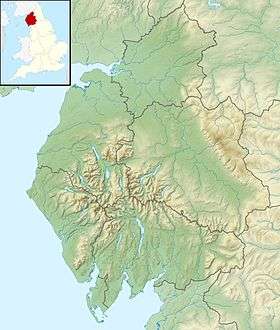Moorside Nuclear Power Station
| Moorside nuclear power station | |
|---|---|
 Location of Moorside Nuclear Power Station | |
| Country | United Kingdom |
| Location | Sellafield, Cumbria |
| Coordinates | 54°25′46″N 3°30′39″W / 54.429566°N 3.510911°WCoordinates: 54°25′46″N 3°30′39″W / 54.429566°N 3.510911°W |
| Status | Proposed |
| Construction cost | £10 billion |
| Owner(s) | NuGen |
| Operator(s) | Engie |
| Nuclear power station | |
| Reactor type | AP1000 PWR |
| Reactor supplier | Westinghouse |
| Power generation | |
| Units planned | 3 |
| Nameplate capacity | 3,400 MW |
|
Website www | |
Moorside Nuclear Power Station is a proposal to build three AP1000 nuclear reactors on a site near Sellafield, in Cumbria, United Kingdom.[1] The plan by NuGeneration, which is the British subsidiary of Toshiba-owned Westinghouse Electric Company, has the station coming online from 2024 with 3.4GW of new nuclear capacity. Work up to 2018 would include acquiring the site licence, the development consent order, and other required permits and permissions to start work. Site preparation would take two years, up to 2020.[2]
History
In 2014, the Nuclear Decommissioning Authority agreed commercial terms with developer NuGen to extend a land option agreement to build three reactors at Moorside.[3] Later that year, HM Treasury agreed to provide financial security to investors in the project.[4]
In July 2015, NuGen purchased the land near Sellafield needed for the Moorside, approximately 200 hectares, for an undisclosed sum.[5]
In October 2016, National Grid announced proposals for consultation for a £2.8 billion project to connect the new plant to the national electricity grid. The proposal involves putting power-lines underground and under Morecambe Bay to reduce the impact on the Lake District National Park.[6]
AP1000 reactor design
The AP1000 is a nuclear power plant designed and sold by Westinghouse. The plant is a pressurised water reactor (PWR) with improved use of passive nuclear safety. The design has fewer valves and pumps than previous PWRs and allows cooling without intervention for up to 72 hours, relying mostly on natural processes such as water flowing downhill and heat rising. This novel design has raised a number of concerns but the design has been approved for use in both the United States and China.
In December 2011, the Office for Nuclear Regulation (ONR) and Environment Agency (EA) had issued interim design acceptance for the AP1000 reactor design. These indicated that there were 51 outstanding issues and the ONR and EA were satisfied with the plans to resolve these issues.[7] The issues include "Justification of novel form of structure for the steel/concrete composite walls and floors known as CA modules"[8]
In 2015 Westinghouse resumed ONR Generic Design Assessment for Moorside. On 28 March 2017 the ONR issued a Design Acceptance Confirmation for the AP1000 design, stating that the 51 issues identified in 2011 had received an adequate response.[9][10] However, the following day the designer, Westinghouse, filed for Chapter 11 bankruptcy in the U.S. because of $9 billion of losses from its nuclear reactor construction projects, mostly the construction of four AP1000 reactors in the U.S. It is unclear so far what effect this might have on the Moorside development.[11]
Opposition
The proposal to build the station is opposed by Radiation Free Lakeland, a group of local activists.[12]
A report [13] commissioned by Radiation Free Lakeland[14] is critical of the AP1000 reactor design and has been written by the Edinburgh Energy and Environment Consultancy.[15] The report says that "The AP1000 reactor design is not fit for purpose and so should be refused a Design Acceptance Confirmation (DAC) and Statement of Design Acceptability (SDA)″.
Consultation
Stage 1 consultation took place between May and July 2015 and a report was published on 23 November 2015. Stage 2 consultation took place between May and July 2016.[16]
References
- ↑ "The Moorside project". The Copeland Centre. Retrieved 2 May 2014.
- ↑ "First AP1000 at Moorside online by 2024, Westinghouse says". Nuclear Engineering International. Retrieved 2 May 2014.
- ↑ "NuGen progresses Moorside nuke plans". The Construction Index. Retrieved 2 May 2014.
- ↑ "New Cumbria nuclear plant moves another step forward". Press release from Department of Energy and Climate Change. gov.uk. Retrieved 18 December 2014.
- ↑ "NuGen acquires land for Moorside project". World Nuclear News. 14 July 2015. Retrieved 26 July 2015.
- ↑ "UK's National Grid updates plans for new nuclear plants". World Nuclear News. 25 October 2016. Retrieved 27 October 2016.
- ↑ http://www.onr.org.uk/new-reactors/ap1000/idac-isoda.htm
- ↑ http://www.onr.org.uk/new-reactors/ap1000/gda-issues-res-plan.htm
- ↑ "AP1000 design completes UK regulatory assessment". World Nuclear News. 30 March 2017. Retrieved 8 April 2017.
- ↑ "New nuclear power stations: Generic Design Assessment: Design Acceptance Confirmation for the AP1000® Reactor" (PDF). ONR. 28 March 2017. Retrieved 8 April 2017.
- ↑ "Westinghouse files for bankruptcy". Nuclear Engineering International. 29 March 2017. Retrieved 4 April 2017.
- ↑ Clarke, Andrew (27 September 2014). "Protest campaign launched against nuclear power station near Sellafield". News and Star. Carlisle. Retrieved 8 December 2014.
- ↑ http://www.theecologist.org/blogs_and_comments/commentators/2988356/ap1000_reactor_design_is_dangerous_and_not_fit_for_purpose.html
- ↑ http://www.newsandstar.co.uk/news/Moorside-reactors-too-great-a-risk-to-public-health-and-safety-report-claims-fed10206-dff5-40b0-a060-e085ef48204e-ds
- ↑ http://eee-consultancy.co.uk/
- ↑ "Stage Two Consultation". Retrieved 28 April 2017.